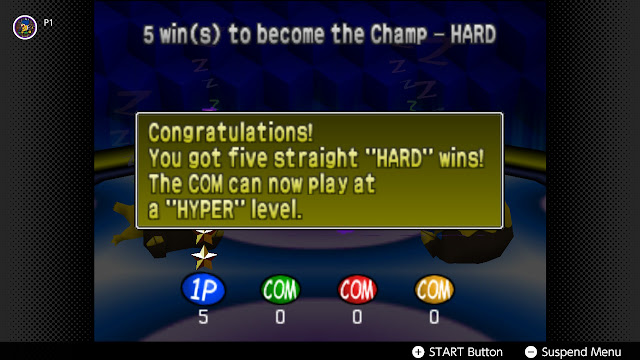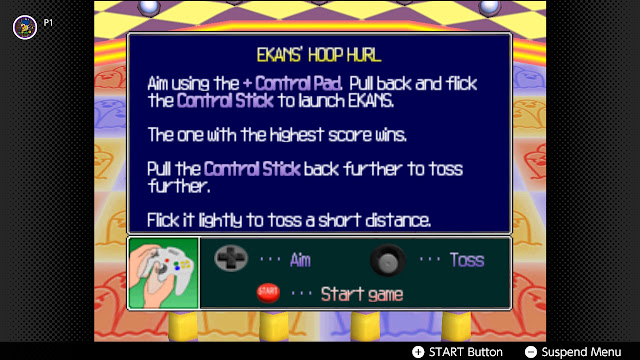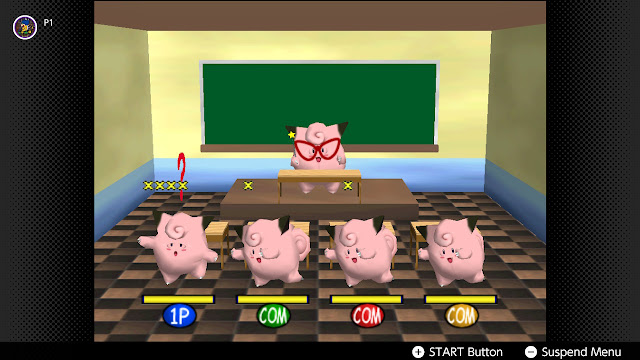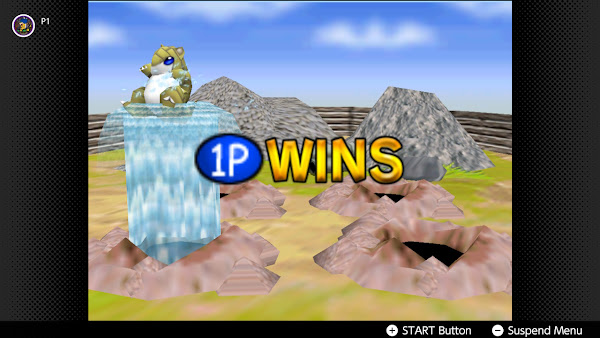 By LUDWIG VON KOOPA - Worst-to-best of the nine minigames in Pokémon Stadium!
By LUDWIG VON KOOPA - Worst-to-best of the nine minigames in Pokémon Stadium!
A few months back right after the first Pokémon Stadium became available on the Nintendo 64 emulator on Nintendo Switch Online + Expansion Pack, I wrote an article about how Generation 1 mechanics really don't hold up today. I also wrote about how the minigame aspect (the Kids Club) is overrated, because the quality of the minigames themselves are lacking. Today, I'm going to go into more detail about those minigames and how they are designed, rating them in a worst-to-best tier list. My experiences are based on playing the minigames both with three other computer players, as well as with other real people. Also, note that my ratings are based on playing Pokémon Stadium on the Nintendo Switch. I DID play it on the Nintendo 64, but my game design thoughts are significantly more refined now.
 |
| If you get five minigame wins in a row in “Who's the best?” mode on HARD difficulty, you'll unlock HYPER difficulty. It's not more fun than HARD, and winning is sometimes impossible. |
Ekans’ Hoop Hurl
- In-game Description:
- Aim using the + Control Pad. Pull back and flick the Control Stick to launch EKANS.
- The one with the highest score wins.
- Pull the Control Stick back further to toss further.
- Flick it lightly to toss a short distance.
- Featured Pokémon
- Ekans (controlled), Diglett (objective), Dugtrio (design of the floor)
- Time
- 60 seconds. The player with the highest score at the end of that time wins. Ties are possible.
I'd like to show you the in-game description below. Pay particular attention at the photo of how you are supposed to hold the controller. Note that controllers don't look like this anymore: Both the Nintendo Switch Pro Controller and Nintendo GameCube Controller, as examples, have the Control Stick at the top left of the controller and a D-Pad southeast of it. Those controllers also have two prongs for two-handed people, instead of the Nintendo 64's three prongs for three-handed people:
 |
| This particular Nintendo 64 controller design scheme just does not translate well to anything else. I wonder how it controls using the Nintendo 64 controller that is always sold out from Nintendo's store. (I still don't think it'd be fun.) |
Besides how uncomfortable this control scheme is, the game suffers from the control stick motion itself. There are three launch strengths for Ekans corresponding to the three rows. However, modern controllers are nowhere near as discerning and sensitive as the Nintendo 64 controller apparently used to be, so you're going to have a very difficult time launching Ekans where you want to. (I think the GameCube Controller is better than the Switch Pro Controller, which is better than the Switch Joy-Cons.) Since you're competing against three other players, speed is of the essence—if your Ekans is wrapped around a Diglett, that Diglett becomes unavailable for other players to score off of. This is particularly important for the rare Gold Diglett that's worth TWO points. But you can't really control the Control Stick's launch power in a timely manner. The controls prevent this game from being a fun (or winnable) experience.
Thundering Dynamo
- In-game Description:
- When the lamp is blue, tap the A Button repeatedly to charge electricity. Tap the B Button when it's green.
- Pressing the wrong button drains your stored electricity.
- The first one to be fully charged wins.
- Featured Pokémon
- Pikachu or Voltorb (both controllable, it's random which you get)
- Time
- This could be over within ten seconds.
 |
| It seems like a waste to power this dynamo only to immediately discharge the electricity to the “volunteers.” |
Run, Rattata, Run
- In-game Description:
- Tap the A Button repeatedly to run.
- Press up on the Control Pad to jump over hurdles.
- The first one to the goal wins.
- Featured Pokémon
- Rattata (controlled).
- Time
- This should take about twenty seconds.
 |
| The camera rotates while you're playing the game, for maximum discomfort. |
DIG! DIG! DIG!
- In-game Description:
- Tap the L and R Buttons back and forth to make SANDSHREW DIG.
- The first one to hit water wins.
- Tapping the same button twice makes SANDSHREW stop.
- Featured Pokémon
- Sandshrew (controlled).
- Time
- You should win in about eight seconds.
Snore War
- In-game Description:
- Press the A Button when the pendulum gets to the center red needle to cast HYPNOSIS.
- The last one awake wins.
- Featured Pokémon
- Drowzee (controlled).
- Time
- It should take forty seconds... at most until all of the Drowzee are asleep.
 |
| Yeah, that's my sleepy Drowzee. I wonder what Drowzee thinks of the research presented at SLEEP 2023, America's sleep professionals conference. |
Upon playing the minigame with four controllers that do nothing, I've figured out that the minigame will go on forever. So it's not an HP-based system... someone does need to press A. And the pendulum will get faster and faster even if no one is pressing A. So... I don't understand how the game works. Maybe it's the first Drowzee to cast a certain number of successful Hypnosis? And that number is dynamically determined by how many failures the other Drowzee get?
Magikarp's Splash
- In-game Description:
- Make MAGIKARP SPLASH hit and hit the counter to score.
- Press and hold the A Button to make MAGIKARP SPLASH high.
- Press the A Button just as MAGIKARP lands for quick SPLASHes.
- Featured Pokémon
- Magikarp (controlled).
- Time
- Twenty seconds (though the timer is invisible).
 |
| KARP KARP KARP Player 1 has the lowest counter because I pressed the screenshot button instead of focusing on my A timing. |
I originally had Snore War in a superior position compared to Magikarp's Splash, but my calling it an Action Command simulator got me all nostalgic for Paper Mario, so I raised the position. That, and the actual method of progress / victory in Snore War being unexplained. Meanwhile, you always know your standing in Magikarp's Splash, which increases the competitive nature and pressure of the minigame. I think that works to its benefit, since being able to create such emotions in your players is a sign of powerful and cohesive game design.
Clefairy Says
- In-game Description:
- Remember the arrows on the blackboard. When the teacher tells you, enter the arrow directions on the Control Pad.
- The best student wins.
- Featured Pokémon
- Clefairy (controlled, except for the teacher Clefairy).
- Time
- There are five rounds. Four directions, four + two, six + two, eight + two, and then ten + two.
Clefairy Says is infamous for several reasons. One is the... intoxicating singing voice that Clefairy has when singing the directions. Another is the fact that you can easily cheat in the game and just write down Clefairy's directions. You might also find it scary or endearing how the Clefairy teacher bonks you with a hammer if you get something wrong, and the fact that you even have an HP metre to represent this (you can take five hits before you're out of the running, but whomever gets bonked the least wins). Depending on how you like memorisation games, you'll love Clefairy Says.
 |
| Clefairy looks so helpless and clueless when it has no clue what's next. |
A note on how this works: You're initially given four directions, and then the game adds two more directions on top of the ones you've already done, until there are twelve. That means you need to retain what you're doing while having room to add new things. If you mess something up, your mistakes are likely to snowball on top of one another, so you might make five mistakes in one round and instantly lose.
 |
| The very existence of this screenshot proves I'm a cheater. What is Clefairy gonna do, expel me from the school? I don't wanna be there anyway!
The game gets credit for not letting you see Clefairy's directions on the blackboard if you pause it, but the Nintendo Switch has superpowers. This reminds me of how the Nintendo Switch similarly lets you cheat versus Ōkami's Blockhead Grande. |
Rock Harden
- In-game Description:
- Press the A Button to HARDEN and avoid being squashed by the boulders.
- HARDEN only works while the A Button is pressed.
- Beware, HARDEN consumes HP.
- Watch for the boulder shadows.
- Featured Pokémon
- Kakuna or Metapod (both controllable, it's random which you get)
- Time
- You probably won't survive for over one minute.
While in Egg Catcher you press (and can hold down) the A button to open Kirby's mouth, in Rock Harden you press (and can hold down) the A button to Harden. Kirby wants his mouth open to catch eggs, but he wants his mouth closed when bombs approach. In Rock Harden, you want to Harden when you're about to be smashed by a boulder, and you don't want to Harden when there aren't boulders around. While Egg Catcher has two objects flying at you (eggs or bombs), Rock Harden innovates by having only one object flying at you, but you still have an important choice of whether to Harden or not, thanks to Harden subtracting from your HP. A frame-perfect (and long) Rock Harden won't consume your HP, but if you hold down A much beyond that, it will. Still, you'll lose less HP Hardening than you would getting crushed by a rock.
While Egg Catcher is a matter of timing, Rock Harden really ups the risk-reward factor by making it a multiplayer experience. You don't want to just survive the rocks—you want to survive the rocks more efficiently than your opponents do.
Here is a clip of me playing Egg Catcher in Kirby's Return to Dream Land Deluxe (which I bought... and I still haven't played anything besides the first couple of levels and then Egg Catcher in Merry Magoland) and then Rock Harden (with CPUs on Hard) right after. Fortunately, level 3 of Egg Catcher is much more difficult than the level 1 of Egg Catcher we initially saw when it was announced it'd return in Kirby's Return to Dream Land Deluxe.
Multiplayer Egg Catcher is just four people playing Egg Catcher at once (in parallel) and then comparing scores afterward. You'd play it the exact same way regardless of if someone else was playing it. But with Rock Harden, you will play more riskily if you notice you're behind. That means you'll take the risk of pressing A at precisely the right frame, instead of giving yourself a buffer window of holding down A a little earlier. Your HP is the only measure of success, but you may lose more HP (by getting hit with a rock) than conserve HP if you try to be optimal. It's a very interesting dynamic.
Also, unlike Egg Catcher's limited variations, the rock patterns in Rock Harden are at least semi-random, especially because it is survival-based instead of being based on a finite and pre-determined number of eggs (thirty), so it can keep going and going.
Sushi-Go-Round
- In-game Description:
- Press the A Button to eat the sushi.
- The biggest spender wins.
- Eat the same kind in a row to score more points.
- Featured Pokémon
- Lickitung (controlled)
- Time
- You'll eat sushi for one minute, though there isn't an in-game timer.
Why is Sushi-Go-Round ranked at the top? Unlike... every other minigame in Pokémon Stadium, Sushi-Go-Round has several elements of decision-making. The other minigames are just execution tests. That's notable, because the only reason anyone would've bought Pokémon Stadium is if they're a fan of the Pokémon series battle system, which is a system entirely based on making decisions around your available options in the context of your current situation—the options available to you are always changing.
 |
| You need to remember the values of each sushi, similar to how you might remember a Pokémon type chart or base stats. Orange > Red > Yellow > Green. |
Specifically, you have to decide where your Lickitung will be and what to try to eat. You need to decide whether you want to try to get a combo (by eating the same type of sushi consecutively)—passing up other opportunities in the process—or just go for whatever is circulating that's the highest point value. If none of the Lickitung eat anything, the same twelve sushi plates will keep circling around. New sushi only appears after existing sushi has been eaten, which means if EVERY Lickitung is holding out for a combo, and none of what they want is around, someone will have to lick the figurative bullet. Some of the sushi is spicier than others, and Lickitung may be out of commission for a couple of seconds if it indulges in that too much. Is that worth the higher point value?
You may even decide to sabotage a competitor's combo—Sushi-Go-Round is the only minigame besides Ekans’ Hoop Hurl where you can directly affect your opponents, as opposed to four people playing in parallel. Combos are powerful, because you can easily get a high total value by eating fewer things, but they are risky and tough to get. That's part of the risk-reward decision making in Sushi-Go-Round that, again, isn't available in other minigames (while it's in Rock Harden, it's still ultimately still tied to your execution abilities instead of your cerebral abilities), but is also inherent in what makes games in general interesting.
Sushi-Go-Round isn't a perfect minigame—I find Lickitung's actual tongue animation to feel delayed and underwhelming compared to what it should be... and it's kind of gross. I also find it difficult to remember which of the red sushi is best, but that's probably my problem and not the game's. It also makes me want to eat sushi, which is definitely my problem.
Ludwig's personal favourite minigame is Rock Harden, but Sushi-Go-Round is objectively the better minigame, so it gets the top placement. Do you disagree with Ludwig's placements? Do you agree with him that the majority of the nine games are worse than middling? Are you able to be delicate enough that you actually can play Ekans’ Hoop Hurl on a Nintendo Switch and be left satisfied? Let KoopaTV know in the comments section!
Ludwig wrote a similar tier list for the minigames in Ring Fit Adventure.
Ludwig also wrote a similar tier list (but from best-to-worst) for the minigames in No More Heroes 3.
A lot of the controls in these minigames are difficult for left-handed players, though Ludwig didn't take that into consideration.
Because Rock Harden was Ludwig's favourite game, he went and made his own free, browser-based videogame that evolved its design sensibilities called Fire Withdraw.


Now when will you bring up the sequel so you can talk about Furret's Frolic and how a Girafarig guest stars in it.
ReplyDeleteWell, when will Stadium 2 be on NSO?
Delete